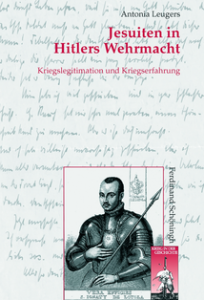Contemporary Church History Quarterly
Volume 31, Number 2 (Summer 2025)
Jörg Seiler, ed. Literatur – Gender – Konfession: Katholische Schriftstellerinnen, Vol. 1. Forschungsperspektiven. Regensburg: Verlag Friedrich Pustet, 2018, pp. 216.
Antonia Leugers, Literatur – Gender – Konfession: Katholische Schriftstellerinnen .Vol. 2. Analysen und Ergebnisse. Regensburg: Verlag Friedrich Pustet, 2020, pp. 288.
Dominik Schindler, “Michael von Faulhaber und die katholische Frauenbewegung (1903-1917). Zeitgemäße Seelsorge eines modernen Bischofs.” In Katharina Krips, Stephan Mokry, Klaus Unterburger, eds. Aufbruch in der Zeit: Kirchenreform und europäischer Katholizismus. Stuttgart: W. Kohlhammer, 2020, pp. 207-220.
By Martin Menke, Rivier University
In the ever-widening definition of church history, the role of women of faith remains an open field. The three contributions under review here demonstrate not only the extent of research that remains to be done but also the significant contribution that Christian women’s history makes to a greater understanding of Christian life in general, especially in the twentieth century. The first two volumes under consideration are the result of a multi-year grant-funded study on Catholic women authors from 1900 to the Second Vatican Council (1962-1965), while the single chapter throws new light on the support of Michael von Faulhaber, before his appointment as archbishop of Munich, for Catholic women’s groups as well as his views of the woman’s role in church and society.
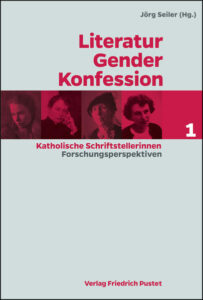 The study on Catholic women authors was funded by the Deutsche Forschungsgemeinschaft and based at the University of Erfurt. Antonia Leugers, Jörg Seiler, and Lucia Scherzberg, well-known historians of German Catholicism, as well as other church historians and several literature scholars and experts in database-supported research, collaborated on this study. Establishing a database of 160 Catholic women authors, as many as the grant permitted, the participants welcome future scholars to append additional writers, especially from earlier and later periods, to the historical record.
The study on Catholic women authors was funded by the Deutsche Forschungsgemeinschaft and based at the University of Erfurt. Antonia Leugers, Jörg Seiler, and Lucia Scherzberg, well-known historians of German Catholicism, as well as other church historians and several literature scholars and experts in database-supported research, collaborated on this study. Establishing a database of 160 Catholic women authors, as many as the grant permitted, the participants welcome future scholars to append additional writers, especially from earlier and later periods, to the historical record.
Based on theoretical concepts such as Pierre Bourdieu’s notion of “symbolic power” and Kimberlé Crenshaw’s theory of intersectionality, the researchers inquired how these women fared as women authors and whether the authors met contemporary ideals concerning Catholic women. Did they dedicate their careers to upholding these ideals? Did identifiable subgroups exist? Which works caused scandal, which were forbidden, either by the Reichsschrifttumskammer or the Allied powers? Which authors went into exile? How did that experience change their views? While the volumes answer these questions, they lack effective summaries that conclude “indicators of processes by which these authors emancipated themselves from church norms by analyzing their fictitious characters” (vol. II, Leugers, p. 10) The authors of this volume analyze the degree to which Catholic women authors, in their personal lives and their fiction, adhere to the Catholic image of womanhood promoted by both the church and secular society, especially by the National Socialist regime. Many authors in their lives and their works differ from both Church and social expectations in matters of marriage, chastity, parenthood, and gender.
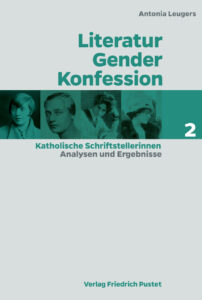 Instead, the volumes offer a wealth of case studies. Some of the authors, such as Gertrud von le Fort and Hedwig Dransfeld, were well-known, while others published only a few works. Each of the authors has their history. The Leugers volume includes a primarily quantitative summary of the women’s experiences, how many got divorced, converted to Catholicism, left the church, lived in same-sex relationships, had children out of wedlock, attempted suicide, chose cremation, were childless, etc. Leugers admits, however, that such personal information is sometimes difficult to obtain and that, given the limited sample, the data are more “symptomatic” than representative. This detailed qualitative analysis, however, lacks explanatory power. The more important questions raised in the project remain unanswered. The authors offer no conclusions about Catholic women’s emancipation, their understanding of gender, chastity, and parenthood. While some suggest disapproval of modernity, most suggest ways of accommodating it while maintaining a life of faith. In all cases, Catholic faith triumphs. Beyond this, however, this rich body of evidence cries for additional meaningful analysis. One wonders if these volumes report results from which results can be drawn.
Instead, the volumes offer a wealth of case studies. Some of the authors, such as Gertrud von le Fort and Hedwig Dransfeld, were well-known, while others published only a few works. Each of the authors has their history. The Leugers volume includes a primarily quantitative summary of the women’s experiences, how many got divorced, converted to Catholicism, left the church, lived in same-sex relationships, had children out of wedlock, attempted suicide, chose cremation, were childless, etc. Leugers admits, however, that such personal information is sometimes difficult to obtain and that, given the limited sample, the data are more “symptomatic” than representative. This detailed qualitative analysis, however, lacks explanatory power. The more important questions raised in the project remain unanswered. The authors offer no conclusions about Catholic women’s emancipation, their understanding of gender, chastity, and parenthood. While some suggest disapproval of modernity, most suggest ways of accommodating it while maintaining a life of faith. In all cases, Catholic faith triumphs. Beyond this, however, this rich body of evidence cries for additional meaningful analysis. One wonders if these volumes report results from which results can be drawn.
Determining a work’s effect, i.e., its reception history, remains difficult. The project includes contemporary critiques of the authors’ works, mostly by Catholic publications. Many of the works were considered trivial. Those authors who adhered most closely to Catholic moral standards tended to fare well in the reviews. Those who problematized Catholic teaching or offered differentiated explanations of human behavior were often condemned by church authorities and Catholic publications. For the period 1933-1945, the detailed records of the Reichsschriftumskammer, which evaluated the publications for ideological conformity or at least compatibility, offer insights into the works. One of the regime’s objections was the Catholic praise for virginity and chastity. The regime denigrated women who chose not to bear children. A final measure of a work’s popularity was the number of volumes printed. In some cases, new editions were published well after the war, while other works sold only a few hundred copies.
While the research summary volume by Leugers, the second in the trilogy, focuses on the various types of Catholic women authors, the contributors to the Seiler volume, the first in the series (these two volumes are reviewed here; the third volume, also edited by Seiler, discusses the literary conflict between Carl Muth and more conservative, orthodox groups), offer insights useful for future scholars. Lucia Scherzberg, for example, analyzes the gendering of God throughout history and how Protestantism is often defined as male, while Catholicism is usually described as female. She asks how the authors constructed gender and what role religious affiliation plays in constructing gender. In general, she inquires about the role that gender plays in the thinking and works of these authors. Scherzberg provides no answers and poses these questions to future scholars.
In an apparent rebuke to Leugers, Scherzberg also questions “whether or not social scientific theory can capture the contingency of historical processes.” Social scientific theories often cannot provide micro-historical explanations.
Günter Häntzschel discusses Catholic lyric poetry. Interesting is his summary of the conflict between Carl Muth, who founded Hochland, the premier intellectual Catholic journal of the period before World War II, and who sought to establish Catholic literature independent of Catholic teaching, and Richard Gralik, who founded the Gral as a conservative Catholic magazine. Muth became the driving force behind an independent non-ecclesiastical Catholic intellectual life in Germany. Maria Cristina Giacomin addresses Muth’s concern about inferior Catholic literature more directly. Muth feared that Catholic literature, directed primarily at women and older girls, had been feminized. The first novel by a woman that Muth published in Hochland was a complex account of an anti-Catholic man and the Catholic woman who denounces him as a Lutheran for blasphemous desecration, but also reconciles him with the Catholic faith. Gendered religious identities, erotic undertones, and the protagonist’s refusal to bear children yielded much criticism. Giacomin argues that Catholic readers at the time were accustomed to clearly didactic novels in which the Catholic moral lesson was presented unambiguously.
Regina Heyder explains that while Catholics considered women’s chastity and virginity laudable before 1945, in the post-war era, chastity was considered a burdensome outcome of fate. Several authors explain that Catholic women authors described convent schools as places of repression and punishment, but also, more importantly, as places dominated by obscurantism and “void of intellectual and artistic nourishment” (Seiler, 166).
Martin Papenbrock analyzes book covers from the Beaux-Arts style to post-war modernity. While offering little commentary on the works’ Catholicism, he notes that publishers often commission book covers that do not accurately reflect the nuanced discussions provided in the text. They reflect more the times in which the book was published than its contents.
While both volumes lack an analytical, summative conclusion, they complicate scholars’ understanding of twentieth-century Catholicism. Women who read and could afford books, or who sought out lending libraries, were offered a differentiated and challenging image of Catholic womanhood, one that demands further analysis and explanation. These works paint a more complicated picture of Catholic womanhood, as the views of womanhood discussed in these volumes were ascribed to Catholic men of their subjects’ time, and ecclesiastical concerns about “modern” Catholic women. Most importantly, the volumes offer evidence of the significance to Catholic social, moral and cultural history of women’s agency.
 Another instance in which women’s agency proved important can be found in Dominik Schindler’s discussion of the relationship between the Katholische Deutsche Frauenbund and Michael von Faulhaber, a theology professor at Strasbourg and bishop of Speyer. In a nuanced brief essay, Schindler argues that Faulhaber actively supported the formation of the Frauenbund and the Hildburgisbund, an organization supporting female university students. According to Schindler, Faulhaber largely adhered to traditional values, but insisted that Catholic values reflect the equal role many Catholic women played in securing the family’s income. He also argued publicly that Catholic theology proved no obstacle to women’s suffrage. While men remained heads of household, this did not consign women to second-class status. Faulhaber’s view of the family remained conservative. Still, he acknowledged that in an industrial society, a man’s wages might not suffice to meet the family’s expenses, and thus a woman might be forced to work. Faulhaber argued that women from the upper classes should be encouraged to participate in social and cultural life. In contrast, women in the lower classes deserved much support to earn an honorable living. He believed that women’s work was necessary to meet the needs of their children. Schindler argues that, even if Faulhaber’s views seem backward today, at the time, they were quite progressive.
Another instance in which women’s agency proved important can be found in Dominik Schindler’s discussion of the relationship between the Katholische Deutsche Frauenbund and Michael von Faulhaber, a theology professor at Strasbourg and bishop of Speyer. In a nuanced brief essay, Schindler argues that Faulhaber actively supported the formation of the Frauenbund and the Hildburgisbund, an organization supporting female university students. According to Schindler, Faulhaber largely adhered to traditional values, but insisted that Catholic values reflect the equal role many Catholic women played in securing the family’s income. He also argued publicly that Catholic theology proved no obstacle to women’s suffrage. While men remained heads of household, this did not consign women to second-class status. Faulhaber’s view of the family remained conservative. Still, he acknowledged that in an industrial society, a man’s wages might not suffice to meet the family’s expenses, and thus a woman might be forced to work. Faulhaber argued that women from the upper classes should be encouraged to participate in social and cultural life. In contrast, women in the lower classes deserved much support to earn an honorable living. He believed that women’s work was necessary to meet the needs of their children. Schindler argues that, even if Faulhaber’s views seem backward today, at the time, they were quite progressive.
The three works in question raise more questions than they answer, but there is justification for such works. While Laura Fetheringill Zwicker, Martina Cucchiara, and others, including the scholarship reviewed here, have made inroads into German Catholic women’s history, much work remains to be done, work that will enrich the record and challenge scholars to be sensitive to greater differentiation.

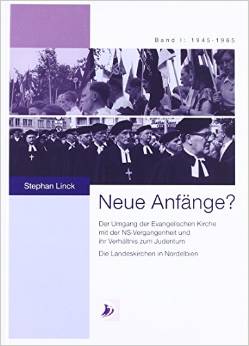
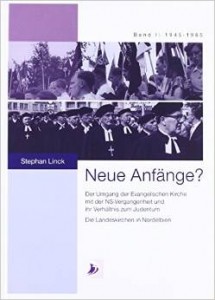 In Neue Anfänge? Der Umgang der Evangelischen Kirche mit der NS-Vergangenheit und ihr Verhältnis zum Judentum. Die Landeskirchen in Nordelbien. Band 1: 1945-1965, Stephan Linck analyses the situation in the four Protestant churches which united in 2012 to form the Evangelical Church of North Elbia. He had earlier organized a travelling exhibition which did much to break the silence about these churches’ failures in former years. His central point is that this part of Germany had a long history of extreme nationalism, backed by Lutheran authoritarianism. This made these congregations particularly susceptible to Nazi anti-Semitic propaganda and encouraged their extremist and anti-communist attitudes, which were only reinforced in this region after 1945, when so many refugees fled to the region to escape the Russian occupation and the subsequent Communist domination of eastern Europe. These churches’ active support of the refugees’ desire to regain their homelands, in Linck’s view, only exacerbated their reactionary political attitudes and entrenched their prejudices.
In Neue Anfänge? Der Umgang der Evangelischen Kirche mit der NS-Vergangenheit und ihr Verhältnis zum Judentum. Die Landeskirchen in Nordelbien. Band 1: 1945-1965, Stephan Linck analyses the situation in the four Protestant churches which united in 2012 to form the Evangelical Church of North Elbia. He had earlier organized a travelling exhibition which did much to break the silence about these churches’ failures in former years. His central point is that this part of Germany had a long history of extreme nationalism, backed by Lutheran authoritarianism. This made these congregations particularly susceptible to Nazi anti-Semitic propaganda and encouraged their extremist and anti-communist attitudes, which were only reinforced in this region after 1945, when so many refugees fled to the region to escape the Russian occupation and the subsequent Communist domination of eastern Europe. These churches’ active support of the refugees’ desire to regain their homelands, in Linck’s view, only exacerbated their reactionary political attitudes and entrenched their prejudices.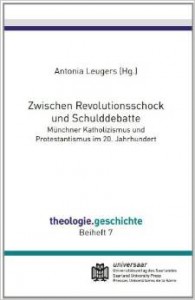 These same features were on display in the Bavarian Protestant Church, too. They are the subject of Björn Mensing’s chapter in the collection of essays edited by Antonia Leugers, entitled Zwischen Revolutionsschock und Schulddebatte. Münchner Katholizismus und Protestantismus im 20. Jahrhundert. Mensing also comments acerbically on the apologetic and self-serving accounts of Bavarian Protestantism written by survivors, which excused the early and enthusiastic support given to Adolf Hitler as stemming from a desire to prevent a victory for Communism and as a sign of the “rechristianising” of a war-torn Germany. Those few voices calling for a more critical and less self-justifying account of the Nazi years were quickly sidelined. So too those who had been involved in the 1944 plot to overthrow Hitler and had been executed as a result, such as Dietrich Bonhoeffer, were regarded by the majority of the Bavarian Protestant leaders as “traitors to the national cause”. Mensing, who is now the Pastor of the Church of Reconciliation erected in the former concentration camp at Dachau, recounts with some bitterness the opposition to the building of this chapel by the former pro-Nazi pastor of the neighboring parish, clearly backed by the majority of his parishioners. It was only after the generation of participants in the Nazi years had all passed from the scene that a more fitting recognition of the church’s failures and a new sense of repentance could be encouraged. Mensing blames the continuing influence of the conservative leadership in the Bavarian Protestant Church for the slowness with which a greater sense of repentance and reconciliation has at last been adopted. But in view of the entrenched national conservatism of most Bavarian Protestants, Mensing believes there is still a long way to go before the deficiencies of the past can be finally laid to rest.
These same features were on display in the Bavarian Protestant Church, too. They are the subject of Björn Mensing’s chapter in the collection of essays edited by Antonia Leugers, entitled Zwischen Revolutionsschock und Schulddebatte. Münchner Katholizismus und Protestantismus im 20. Jahrhundert. Mensing also comments acerbically on the apologetic and self-serving accounts of Bavarian Protestantism written by survivors, which excused the early and enthusiastic support given to Adolf Hitler as stemming from a desire to prevent a victory for Communism and as a sign of the “rechristianising” of a war-torn Germany. Those few voices calling for a more critical and less self-justifying account of the Nazi years were quickly sidelined. So too those who had been involved in the 1944 plot to overthrow Hitler and had been executed as a result, such as Dietrich Bonhoeffer, were regarded by the majority of the Bavarian Protestant leaders as “traitors to the national cause”. Mensing, who is now the Pastor of the Church of Reconciliation erected in the former concentration camp at Dachau, recounts with some bitterness the opposition to the building of this chapel by the former pro-Nazi pastor of the neighboring parish, clearly backed by the majority of his parishioners. It was only after the generation of participants in the Nazi years had all passed from the scene that a more fitting recognition of the church’s failures and a new sense of repentance could be encouraged. Mensing blames the continuing influence of the conservative leadership in the Bavarian Protestant Church for the slowness with which a greater sense of repentance and reconciliation has at last been adopted. But in view of the entrenched national conservatism of most Bavarian Protestants, Mensing believes there is still a long way to go before the deficiencies of the past can be finally laid to rest.